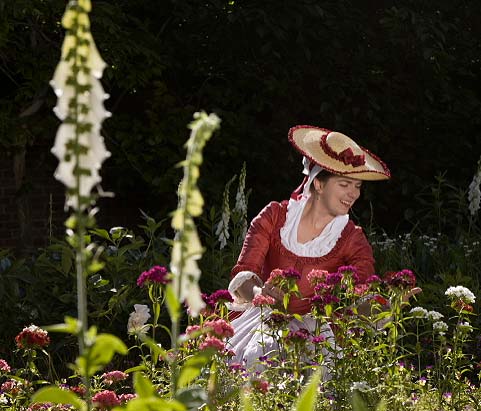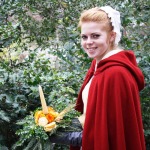
June brings the first onset of really warm temperatures, driving the early flowering trees, shrubs and perennials from the landscape.
The perennial beds at the Governor’s Palace are an abundant mixture of summer phlox (Phlox paniculata), spiderwort (Tradescantia virginiana), Carolina lupine (Thermopsis villosa), daylily (Hemerocallis fulva) and the Yorktown onion (Allium ampeloprasum).
The front edge of the perennial bed is planted in an heirloom mixture of colors of the globe amaranth (Gomphrena globosa), a plant known to have been grown by John Custis in Williamsburg ca. 1735. The permutations of saturated purple, soft pink and dusky white offer a rippling pattern to the front of the perennial beds.
The boxwood garden to the west of the ballroom is planted in a two-toned yellow and pink lantana, whose soft colors and naturally floppy habit give this garden a sense of serenity. To the east of the Palace, in the yellow-berried holly garden, balsam (Impatiens balsamina) has been installed because of the heavy shade on this side of the building. Balsam of this kind can often reach four feet tall and have stems more than two inches in diameter. Their tendency to seed widely and profusely can be troublesome, but they are stout in the heat and floriferous throughout the hot growing year in Williamsburg.
The Colonial Nursery, opposite Bruton Parish Church, is a treasure trove of flowering plants, especially in June. Expect to see sweet bay magnolia (Magnolia virginiana) along with oakleaf hydrangea (Hydrangea quercifolia) and smooth hydrangea (Hydrangea arborescens), the latter of which presents flowers ranging from a flat flower panicle to a more fully spheroid flower head.
In June some traditional perennial herbs are coming into flower or will still be in flower: valerian (Valeriana officinalis) and feverfew (Chrysanthemum parthenium), were both essential healing herbs in antiquity. The yarrows (Achillea millefolium) and (A. fillapendula), the common white and the familiar yellow, have been common in perennial borders for centuries. Both yarrows perform well in the South because of their drought tolerance.
Also expect to see the artichoke-like cardoon (Cynara cardunculus) in bloom as well as a slew of other herbaceous plants such as blattaria, or moth mullein (Verbascum Blattaria), common mullein (Verbascum Thapsus) bergamot (Monarda fistulosa), Stoke’s aster (Stokesia laevis), pink root (Spigelia marilandica), flowering tobacco (Nicotiana syvestris), wormwood (Artemesia Absinthium), and lovage (Levisticum officinale), a celery-like vegetable.
While at the Colonial Nursery , see the tall yellow silphium (Silphium astericus), the sundrops (Oenothera fruticosa), the sea holly (Erygium amethystinum), and the familiar orange butterfly weed (Aesclepias tuberosa).
In addition, look for the familiar rose campion (Lychnis coronaria), clary sage (Salvia sclarea), money plant (Lunaria annua), acanthus (Acanthus mollis) Turk’s cap lily (Lilium martagon) and Madonna lily (Lilium candidum), and the regular and Spanish lavenders (Lavandula angustifolia & L. Stoechas).
In other gardens, such as the Geddy House on Palace Green, look for hollyhocks (Alcea rosea) peeking over the fence. In the oval garden at the Orlando Jones House, the annual bed is planted with a traditional combination of orange marigold and dwarf ageratum.
The great southern magnolia (Magnolia grandiflora) will bloom in June, and no sight of the 10-inch flowers is complete without a whiff of its fragrance: like butter, sugar and lemon folded into cake batter. The prominent catalpa trees (Catalpa bignonioides) on Palace Green bear their huge panicles of flowers in June, and tender their 12-inch seeds pods later in the fall. Don’t miss the bright flowered pomegranates , (Punica granatum) prominent at the Prentis Garden as well as a white ruffled variety at the colonial nursery.


Leave a Reply